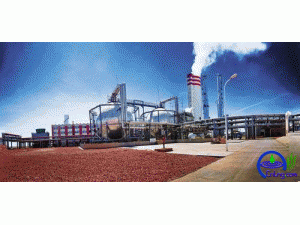
免职声明:本网站为公益性网站,部分信息来自网络,如果涉及贵网站的知识产权,请及时反馈,我们承诺第一时间删除!
This website is a public welfare website, part of the information from the Internet, if it involves the intellectual property rights of your website, please timely feedback, we promise to delete the first time.
尊龙凯时·(中国)人生就是搏!尊龙凯时·(中国)人生就是搏!尊龙凯时·(中国)人生就是搏!电话Tel: 19550540085: QQ号: 929496072 or 邮箱Email: Lng@vip.qq.com
摘要:新疆煤炭资源储量丰富,煤炭产量快速增长,形成以“就地转化为主,疆煤外运为辅”的煤炭消费格局。资源储量方面,新疆作为我国第14个亿吨级大型煤炭基地和五大国家能源战略基地之一,煤炭资源储量极其丰富,预测储量高达2.19万亿吨,约占全国煤炭资源总量的40%左右。..
|
新疆煤炭资源储量丰富,煤炭产量快速增长,形成以“就地转化为主,疆煤外运为辅”的煤炭消费格局。资源储量方面,新疆作为我国第14个亿吨级大型煤炭基地和五大国家能源战略基地之一,煤炭资源储量极其丰富,预测储量高达2.19万亿吨,约占全国煤炭资源总量的40%左右。原煤产量方面,随着我国煤炭开发重心西移,新疆原煤产量快速上升,2017-2023年,原煤产量由1.67亿吨提升至4.57亿吨,年复合增速为18%。煤炭消费方面,新疆煤炭消费以就地转化为主,2023年疆内煤炭消费占全区煤炭产量比重为76%,其中煤电和煤化工消费占比分别为50%和20%。疆煤外运方面,2023年疆煤外运量突破1.1亿吨,外送规模占全区煤炭产量比重为24%。
新疆发电结构以火电为主,“十四五”后期煤电装机仍有近30%增长空间,有望带来约5000万吨的原煤消费增长。2023年,新疆发电量为4912亿千瓦时,其中火力发电量为3790亿千瓦时,占比77%。新疆依托煤炭资源及价格优势,规划尊龙凯时·(中国)人生就是搏!哈密、准东和伊犁三大煤电基地。据北极星火力发电网统计,截至2024年5月,新疆开工火电项目11处、核准火电项目2处,开工项目装机容量为1800万千瓦、核准项目装机容量为264万千瓦,合计约2064万千瓦。未来2-3年,随着开工及核准煤电项目逐步投产,新疆煤电装机将在现有基础上增加28.7%。参照2023年新疆火电行业煤炭消费量约占全区煤炭消费的50%,原煤口径约耗煤1.79亿吨,若火电利用小时数和煤耗保持不变,我们预计新疆28.7%的煤电装机新增量有望带来约5000万吨的原煤消费增长。 Xinjiang is rich in coal reserves, and coal production has grown rapidly, forming a coal consumption pattern with "local conversion as the main, supplemented by Xinjiang coal transportation". In terms of resource reserves, Xinjiang, as the 14th large coal base of 100 million tons in China and one of the five national energy strategic bases, has extremely rich coal reserves, with predicted reserves of up to 219 trillion tons, accounting for about 40% of the total coal resources in the country. In terms of raw coal production, with the westward shift of China's coal development center, Xinjiang's raw coal production has increased rapidly. From 2017 to 2023, raw coal production has increased from 167 million tons to 457 million tons, with a compound annual growth rate of 18%. In terms of coal consumption, Xinjiang's coal consumption is mainly converted locally. In 2023, coal consumption in Xinjiang will account for 76% of the region's coal production, of which coal power and coal chemical consumption will account for 50% and 20% respectively. In terms of Xinjiang's coal export, in 2023, Xinjiang's coal export volume exceeded 110 million tons, and the export scale accounted for 24% of the region's coal production. Xinjiang has coordinated economic development within Xinjiang and promoted the export of electricity, and the demand for electricity has increased rapidly, which is still mainly for internal use. At present, Xinjiang's industrial layout is dominated by oil and natural gas mining, electricity and heat production and supply, oil, coal and other fuel processing industries, coal mining and washing industries, and other energy-intensive industries, which drive the rapid increase in electricity demand in Xinjiang. At the same time, with the vigorous implementation of the national strategy of "Xinjiang electricity transmission", especially after the Central Xinjiang Work Symposium was held in 2015, Xinjiang's power industry has also ushered in a period of great development. From the perspective of electricity demand, from 2018 to 2023, the electricity consumption of the whole society in Xinjiang has increased rapidly, and the compound growth rate in the past five years has reached 12.3%. From the perspective of consumption structure, Xinjiang's electricity consumption is mainly for internal use. In 2023, Xinjiang's entire society consumes 382.1 billion KWH of electricity and 126.3 billion KWH of exported electricity, accounting for 76% of Xinjiang's electricity demand. In terms of Xinjiang electricity transmission, with the Changji-Guquan UHV Direct current transmission project put into operation in 2019, a "two-quadrille and two-direct" transmission pattern has been formed. By 2025, with the completion of the Hami-Chongqing DC delivery channel and the Ruoqiang-Huatugou AC delivery channel, a pattern of "three cross-three direct" delivery channels will be formed. At the same time, Xinjiang is accelerating the advance work of the fourth DC channel of "Xinjiang electricity delivery", and cooperating with the promotion of inclusion in national planning, the scale of Xinjiang electricity delivery is expected to continue to expand in the future. Xinjiang's power generation structure is dominated by thermal power, and there is still room for nearly 30% growth in coal power installed capacity in the late period of the 14th Five-Year Plan, which is expected to bring about 50 million tons of raw coal consumption growth. In 2023, Xinjiang will generate 491.2 billion KWH of electricity, of which 379 billion KWH will be generated by thermal power, accounting for 77 percent. Relying on the advantages of coal resources and prices, Xinjiang plans to develop three coal power bases in Hami, Zhundong and Yili. According to the statistics of Polaris Power Grid, as of May 2024, Xinjiang has started 11 thermal power projects and approved 2 thermal power projects, with an installed capacity of 18 million kilowatts and an approved installed capacity of 2.64 million kilowatts, totaling about 20.64 million kilowatts. In the next 2-3 years, with the start and approval of coal power projects gradually put into operation, Xinjiang's coal power installed capacity will increase by 28.7% on the existing basis. In 2023, the coal consumption of Xinjiang thermal power industry accounts for about 50% of the coal consumption in the whole region, and the raw coal caliber consumes about 179 million tons of coal. If the number of thermal power utilization hours and coal consumption remain unchanged, we estimate that the new increase of 28.7% coal power installed capacity in Xinjiang is expected to bring about 50 million tons of raw coal consumption growth. |




 新疆统筹疆内经济尊龙凯时·(中国)人生就是搏!和推动疆电外送,尊龙凯时·(中国)人生就是搏!需求快速提升,仍以疆内自用为主。当前,新疆工业布局以石油和天然气开采业、尊龙凯时·(中国)人生就是搏!热力生产和供应业、石油煤炭及其他燃料加工业和煤炭开采和洗选业等高耗能产业为主,带动疆内用电需求快速增加。与此同时,随着国家“疆电外送”战略的大力实施,特别是2015年中央新疆工作座谈会召开后,新疆尊龙凯时·(中国)人生就是搏!工业也迎来了大尊龙凯时·(中国)人生就是搏!时期。从用电需求看,2018-2023年,新疆全社会用电量快速提升,近5年复合增速达12.3%。从消费结构看,新疆尊龙凯时·(中国)人生就是搏!消费以疆内自用为主,2023年新疆全社会用电量3821亿千瓦时,外送尊龙凯时·(中国)人生就是搏!1263亿千瓦时,疆内用电需求占比76%。疆电外送方面,伴随着昌吉-古泉特高压直流输电工程2019年投运,现已形成“两交两直”外送格局。到2025年,随着哈密-重庆直流外送通道和若羌-花土沟交流外送通道建成,将形成“三交三直”外送六通道格局。同时,新疆正加快推动“疆电外送”第四条直流通道前期工作,配合推动纳入国家规划,未来疆电外送规模有望持续扩大。
新疆统筹疆内经济尊龙凯时·(中国)人生就是搏!和推动疆电外送,尊龙凯时·(中国)人生就是搏!需求快速提升,仍以疆内自用为主。当前,新疆工业布局以石油和天然气开采业、尊龙凯时·(中国)人生就是搏!热力生产和供应业、石油煤炭及其他燃料加工业和煤炭开采和洗选业等高耗能产业为主,带动疆内用电需求快速增加。与此同时,随着国家“疆电外送”战略的大力实施,特别是2015年中央新疆工作座谈会召开后,新疆尊龙凯时·(中国)人生就是搏!工业也迎来了大尊龙凯时·(中国)人生就是搏!时期。从用电需求看,2018-2023年,新疆全社会用电量快速提升,近5年复合增速达12.3%。从消费结构看,新疆尊龙凯时·(中国)人生就是搏!消费以疆内自用为主,2023年新疆全社会用电量3821亿千瓦时,外送尊龙凯时·(中国)人生就是搏!1263亿千瓦时,疆内用电需求占比76%。疆电外送方面,伴随着昌吉-古泉特高压直流输电工程2019年投运,现已形成“两交两直”外送格局。到2025年,随着哈密-重庆直流外送通道和若羌-花土沟交流外送通道建成,将形成“三交三直”外送六通道格局。同时,新疆正加快推动“疆电外送”第四条直流通道前期工作,配合推动纳入国家规划,未来疆电外送规模有望持续扩大。





























